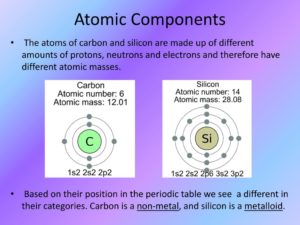May
15
Problems with Silicon-Based Life
Have you ever wondered what life might be like on other planets? As some of my readers know, I am a big sci-fi/fantasy fan, so it’s not surprising that I’ve given this a little thought.
All of the life on our planet is carbon-based, but some people — from scientists to science-fiction writers — have wondered if life, let alone intelligent life, could possibly be based on another element. Boron? Sulphur? Silicon seems to come up as the most popular and likely alternative. And we have seen silicon-based lifeforms represented even in popular TV series — e.g., Star Trek’s Horta race, and probably the Tholians and/or the Crystalline Entity.
But, that’s fiction, and quite speculative at that. What are the real life (pardon the pun) issues as regards the likelihood of silicon-based lifeforms? Astrophysicist Jeff Zweerink addressed this in his book Is There Life Out There?, and I have reproduced the relevant excerpt (plus related material) below….
— — —

“Mendeleev used the fact that various elements share similar chemical properties as the guiding principle to organize the elements in the periodic table. Thus, the obvious place to look for alternatives to carbon is those elements around carbon in the periodic table. Elements in the same row do not have the chemical complexity because they form fewer bonds per atom. Silicon sits immediately under carbon and exhibits many of the same chemical properties, particularly the capacity to form four covalent bonds per atom. When investigated deeper, however, silicon behaves very differently from carbon in some significant ways.
Silicon reacts strongly with oxygen. Because of its high reactivity with oxygen, silicon is not found in a free state on Earth. Instead, it forms silicon dioxide or other silicates. This fact is even more remarkable considering that silicon ranks as the second most abundant element in Earth’s crust (~28%), behind oxygen at ~47%. In contrast, carbon exists in three free forms throughout the Earth in spite of comprising just a fraction of a percent of the crust.
Silicon dioxide is sand, not a gas. The final reaction of carbon compounds with oxygen is carbon dioxide. In this molecule, each carbon atom forms two double bonds with two oxygen atoms. Because of the covalent nature of the double bonds, the interactions between molecules are weak. Thus, carbon dioxide exists as a gas at liquid water temperatures. Silicon atoms are larger than carbon atoms such that silicon can’t form stable double bonds with oxygen. In silicon dioxide the large attraction of oxygen atoms for electrons results in a more ionic type of bond where the oxygen atoms form bridges between the silicon atoms. This bonding structure results in a crystalline solid with a high melting point. Silicon dioxide, also known as silica, is often a major part of sand and is the most abundant compound in Earth’s crust.
Silicon compounds offer little ‘handedness.’ Consider your right and left hand. In an ideal world, both have the same composition and structure, but they cannot be converted from one to the other. They are mirror images, or in more technical terms, they have a definite chirality (or handedness). A large number of the compounds formed by carbon come in mirror-image copies, but that is not true for silicon compounds. Many of the important biological molecules have a definite handedness. In all life on Earth, the amino acids are left-handed, whereas the sugars are right-handed. This handedness plays a critical role in how these molecules react with other substances. For example, the one handedness of naproxen (the active ingredient in Aleve) helps relieve arthritis pain while the opposite handedness causes liver poisoning (while not relieving any pain)! From a biochemical perspective, the functioning of life seems to depend on organic molecules having a specific handedness.

Silicon is relatively inactive at normal temperatures. Even though carbon and silicon can form sufficiently long molecules, carbon reacts with a wealth of other atoms in the range of temperatures where water is liquid. Carbon reacts with oxygen, hydrogen, nitrogen, phosphorus, sulfur, and a host of metals to provide the chemical diversity that life requires. In contrast, silicon reacts with a small number of elements at room temperature, although higher temperatures induce reactions with a few more elements.
Silicon compounds are less abundant in the universe. As astronomers observe the heavens, they detect a large number of elements and molecules in space. A simple analysis of the molecules detected shows that carbon-based molecules vastly outnumber silicon-based ones. For example, one website catalogs all the known interstellar molecules and separates them by the number of atoms the molecules include. The list includes almost 200 molecules [as of 2017], but only 10 or so that contain silicon. Only two of those silicon molecules contain more than four atoms (C4Si and SiH4). Of the 60 molecules detected beyond the Milky Way Galaxy, only one contains silicon (SiO). In contrast, every one of the 60+ molecules with more than 5 atoms contains carbon. Additionally, astronomers have detected more carbon molecules with at least 5 atoms in distant galaxies (18) than silicon molecules of any size in our galaxy.
Scientists have invested great energy trying to understand the chemistry of silicon. Chemists even offer the Frederic Stanley Kipping Award “to recognize distinguished contributions to the field of silicon chemistry and, by such example, to stimulate the creativity of others.” The research over the past few decades show that silicon chemistry was richer than originally expected. Even so, it appears that silicon cannot replace the complex chemistry required for life that carbon so readily offers.”
— — —
At this point, you might have noticed that certain assumptions are being made about what life must look like and the environment it would require. Are Earth-oriented biases keeping us from considering other possibilities? As it happens, that is exactly the question Dr. Zweerink considered next…
— — —

“Discussion and investigation of alternatives to carbon-based life often occurs in the rather limited range of environments experienced on Earth’s surface. This entails a certain temperature range (roughly 0°F to 200°F), pressure range (0.3 atm, on top of Mount Everest, to 250 atm, at hydrothermal vents), oxygen content (none to 0.2 atm), salt concentration (0-30%) and others. Scientists who share Sagan’s view suggest that our relatively small niche environment biases the conclusions we draw in assessing alternative biochemistries. While silicon shows significant deficiencies compared to carbon under Earth conditions, maybe it exhibits the chemical complexity necessary at temperatures associated with liquid nitrogen.
When considering environments different from conditions on Earth, one must also look at solvents besides water and chemistries other than carbon. Pure ammonia (another cosmically abundant molecule) or ammonia/water mixtures remain liquid up to temperatures as low as -110°F at normal Earth pressures. At much higher pressures (60 atm), ammonia remains liquid in much the same temperature range as water (at normal pressure). Other proposed solvents include sulfuric acid, methane/ethane, hydrogen fluoride, and even sodium chloride or silicon dioxide. The latter two materials melt above temperatures of approximately 1,500°F and 2,900°F, respectively. Obviously, these extreme temperatures would require molecules formed from something other than carbon — maybe silicon, oxygen, or aluminum.
Such alternative solvents and backbone elements provide a fascinating arena for new research, and the diverse nature of life found on Earth gives some basis for speculating that perhaps other environments could support a completely different form of life. To explore some of the research into ways life might exist in these bizarre and extreme conditions, see the book titled The Limits of Organic Life in Planetary Systems published by the National Research Council….
[T]heoretical work shows some potential environments where truly alien life (different solvent than water, different chemistry than carbon) might exist. Personally, I find this research both intriguing and fascinating, and I anticipate the results from its continuation. Only by gaining a deeper understanding of how life on Earth operates, by studying how life might be different, and by searching the heavens to see what other planets reveal about the matter will we truly know whether or not life must rely on carbon. With all that said, if I were a betting man, I would still stand with Carl Sagan’s sentiment that the ‘common chauvinism — one which, try as I might, I find I share — is carbon chauvinism.'”
— — —
Fwiw, I would also have to throw in my lot with Zweerink and Sagan on this. Considering what we already know, the interdependencies and other complexities involved, the safe bet is that carbon is the only game (of life) in town… and beyond.















